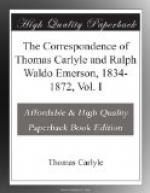CORRESPONDENCE OF CARLYLE AND EMERSON
At the beginning of his “English Traits,” Mr. Emerson, writing of his visit to England in 1833, when he was thirty years old, says that it was mainly the attraction of three or four writers, of whom Carlyle was one, that had led him to Europe. Carlyle’s name was not then generally known, and it illustrates Emerson’s mental attitude that he should have thus early recognized his genius, and felt sympathy with it.
The decade from 1820 to 1830 was a period of unusual dulness in English thought and imagination. All the great literary reputations belonged to the beginning of the century, Byron, Scott, Wordsworth, Coleridge, Shelley, Keats, had said their say. The intellectual life of the new generation had not yet found expression. But toward the end of this time a series of articles, mostly on German literature, appearing in the Edinburgh and in the Foreign Quarterly Review, an essay on Burns, another on Voltaire, still more a paper entitled “Characteristics,” displayed the hand of a master, and a spirit in full sympathy with the hitherto unexpressed tendencies and aspirations of its time, and capable of giving them expression. Here was a writer whose convictions were based upon principles, and whose words stood for realities. His power was slowly acknowledged. As yet Carlyle had received hardly a token of recognition from his contemporaries.
He was living solitary, poor, independent, in “desperate hope,” at Craigenputtock. On August 24,1833, he makes entry in his Journal as follows: “I am left here the solitariest, stranded, most helpless creature that I have been for many years..... Nobody asks me to work at articles. The thing I want to write is quite other than an article... In all times there is a word which spoken to men; to the actual generation of men, would thrill their inmost soul. But the way to find that word? The way to speak it when found?” The next entry in his Journal shows that Carlyle had found the word. It is the name “Ralph Waldo Emerson,” the record of Emerson’s unexpected visit. “I shall never forget the visitor,” wrote Mrs. Carlyle, long afterwards, “who years ago, in the Desert, descended on us, out of the clouds as it were, and made one day there look like enchantment for us, and left me weeping that it was only one day.”
At the time of this memorable visit Emerson was morally not less solitary than Carlyle; he was still less known; his name had been unheard by his host in the desert. But his voice was soon to become also the voice of a leader. With temperaments sharply contrasted, with traditions, inheritances, and circumstances radically different, with views of life and of the universe widely at variance, the souls of these two young men were yet in sympathy, for their characters were based upon the same foundation of principle. In their independence and their sincerity they were alike; they were united in their faith in spiritual truth, and their reverence for it. Their modes of thought of expression were not merely dissimilar, but divergent, and yet, though parted by an ever widening cleft of difference, they knew, as Carlyle said, that beneath it “the rock-strata, miles deep, united again, and their two souls were at one”




